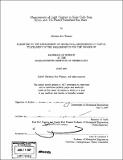Measurement of light capture in solar cells from silver- and tin-plated patterned bus bars
Author(s)
Winiarz, Christine Eve
DownloadFull printable version (1.661Mb)
Other Contributors
Massachusetts Institute of Technology. Dept. of Mechanical Engineering.
Advisor
Emanuel M. Sachs.
Terms of use
Metadata
Show full item recordAbstract
Bus bars on solar cells shade silicon from light. When the bus bars are patterned, they can reflect light back onto the silicon using total internal reflection. These patterned bus bars are tin plated and produce 1-2.5% improvement in module efficiency [6]. There is a potential for even greater improvement by using higher reflectivity metal plating on the bus bars. Silver is the most reflective of all metals, but is also very expensive. We tested to see if silver would actually be as reflective as published values and if silver could redirect a substantial amount of light using total internal reflection. We found that silver plating followed the published spectral dependence curve with little deviation, and would reflect 18.4% more light than the published values for tin. Plating 2.24 microns resulted in 94.9% of reflected light undergoing TIR; the most reflected light of any tested material. Finally, given the current cost of silver is $430 per kilogram and the variable cost of a solar cell is $2 per Watt, the maximum allowable thickness we could afford to plate is 44.8 microns. In our testing, plating as little as 0.35 microns produced a very high light capture. The benefit of silver plating patterned bus bars far outweighs the material costs.
Description
Thesis (S.B.)--Massachusetts Institute of Technology, Dept. of Mechanical Engineering, 2007. Includes bibliographical references (p. 31).
Date issued
2007Department
Massachusetts Institute of Technology. Department of Mechanical EngineeringPublisher
Massachusetts Institute of Technology
Keywords
Mechanical Engineering.